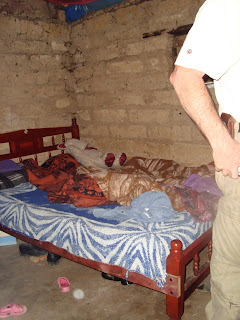Zinacantán is very close to Chamula geographically and the people are closely related linguistically. However, they have reacted very differently and we were told that the two groups do not mingle or intermarry. In Zinacantán, they have adopted a more or less orthodox Roman Catholicism. Outside the cities, all the indigenous grow staples, such as corn, beans etc. However, the groups have different specialties for cash crops. In Chumala, they grow vegetables, especially for San Christobal. In Zinacantán it's flowers. As you come down into the valley, you see dozens of plastic covered greenhouses. The flowers are taken, not only to San Christobal but also into the tourist cities and resorts in the Yucatan. While traditional weaving is carried out by women in all the indigenous groups, women in Zinacantán also embroider white cotton blouses around the neck and shoulders.
The biggest event in Zinacantán was our visit to Maria's house. This was an opportunity to get some insight into daily life of Maya families. The adobe house is a single room, about 15 feet wide and close to 30 long. There is a single door with no windows and no chimney even though they cook on an open wood fire with a flat iron surface. However, there is a gap of several inches between the top of the walls and the roof, which provides ventilation and exit of smoke. We were told that 11 people (3 generations) live in the house. There was only one bed; most of the family sleep on mats woven from reeds on the ground. In one corner is this family altar (see photo above). One of the features of the visit was to experience the basic diet. In the background behind the pink covered table you can see Maria’s daughter-in-law cooking on the wood fire.She is making tortillas in the (almost) traditional way. Corn is cooked and then mashed rather than using corn meal. Finely ground calcium carbonate (limestone the same as used in such preparations as Tums) is added in small amounts. This helps in digestion and in the absorption of nutrients from the corn. With small amounts of water, this is mixed into a paste. Our cook rolled some into a ball. Then, she placed it in a small hand press that smoothed it into a flat tortilla shape.
She is making tortillas in the (almost) traditional way. Corn is cooked and then mashed rather than using corn meal. Finely ground calcium carbonate (limestone the same as used in such preparations as Tums) is added in small amounts. This helps in digestion and in the absorption of nutrients from the corn. With small amounts of water, this is mixed into a paste. Our cook rolled some into a ball. Then, she placed it in a small hand press that smoothed it into a flat tortilla shape. Of course, traditionally, the women worked the dough between her hands, much like pizza makers in Italian restaurants. The tortilla was then placed on the iron plate over the fire and cooked. When cooked, we were given a tortilla; beans had also been cooked and we could spoon some onto the tortilla, roll it up and enjoy. These home made tortillas were thicker and had more texture than the machine made tortillas that we buy or are served in restaurants. I’m not sure if it was just an effect of it being early afternoon and we had had no lunch, but it was rather tasty. Of course, most Mexicans would normally spice it up with generous amounts of picante salsa.
The children are, I think, members of the family, but I’m not sure if all live here. The other photo shows some of the beautiful textiles that Maria had for sale. Near the top, you can see a few of the adobe blocks of the house. More and more, cement blocks are being used, but they are not really as good for temperature control as adobe.
Casa Na Bolom
After our return to San Christóbal in the afternoon. We went to Casa Na Bolom, House of the Jaguar rebuilt and expanded by Frans and Trudi Blom. It is a large, beautiful property that functions as museum, Maya research center, hotel, restaurant and tree nursery. (Google search of Casa Na Bolom has about 15 photos under Images.) There is a large garden behind. One of the statues in the garden is a funny tribute to Diego Rivera the famous Mexican artist who had stayed here as a guest. From the front it just looks like a statue of Rivera, but from behind you see Rivera with a bottle of booze and a prostitute on each arm, a tribute to his well earned reputation as a drinker and womanizer. The Bloms devoted their lives to the Maya and the Lacandón. Trudi had a decades long, close friendship with Chan K’in Viejo, the spiritual leader who lived to be almost 100 years old (see the post on the Lacandón).
After a whirlwind decision to move from Halifax to Mexico. we set out on April 30, 2008. This blog began as an email log to some of our friends. A blog seems a more efficient medium to share impressions. We hope that it is entertaining and even informative.
Wednesday, January 30, 2013
Subscribe to:
Post Comments (Atom)






No comments:
Post a Comment